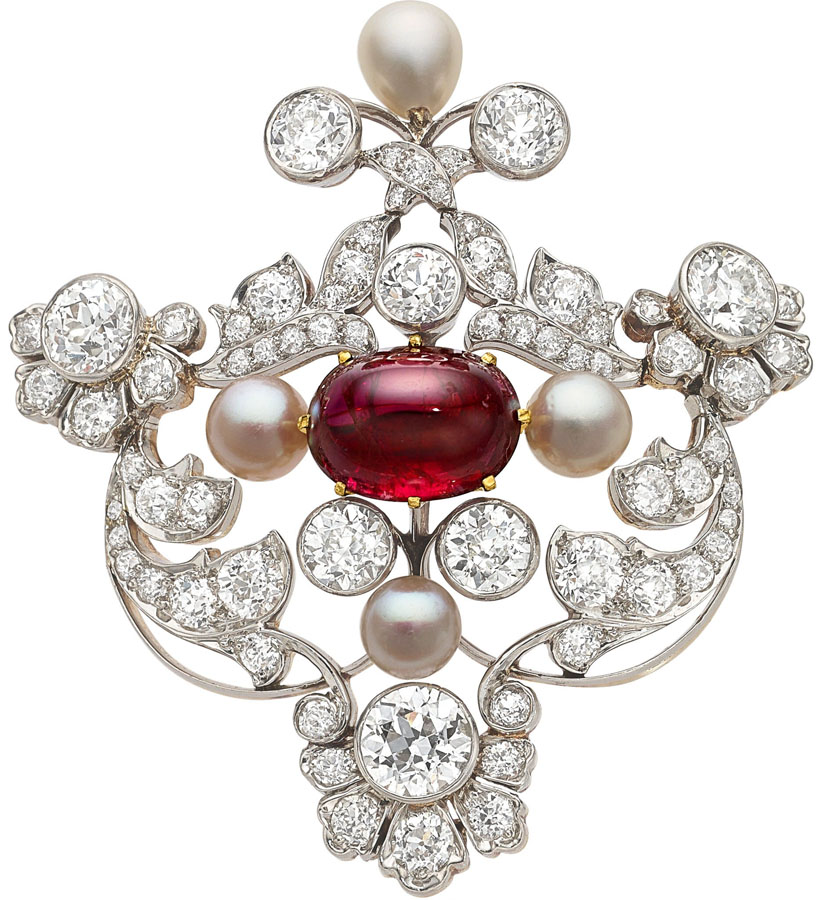A LOOK BACK AT THE DAZZLING EARLY DAYS OF JEWELRY DESIGN IN THE UNITED STATES AND THE TALENTED ARTISTS WHO TOOK THE INDUSTRY TO NEW HEIGHTS
By Katherine van Dell
While the American canon of artists and designers might conjure images of Norman Rockwell’s Thanksgiving table, the ruggedness of Yosemite through the lens of Ansel Adams or a can of Campbell’s soup on repeat, the aesthetic principles and associations surrounding American jewelry are, perhaps, less distinct. Much of this has to do with the origins of craft in America and the diaspora of influences that create the pastiche of our decorative identity. Outside of the intricate beadwork, carving and silversmithing of America’s Indigenous peoples, European colonization of and later immigration to America mark the tenets of handiwork and design so integral to our adornment.
The history of jewelry manufacturing in the United States largely coincides with the industrial revolution of the late 19th century; the influx of European immigrants into what would become major American metropolitan areas; and the crafts, traditions and grit these immigrants brought with them. The greater explosion of industrialism in the West and the untaxed wealth that it generated created a whole new era of adornment and expanded ideas surrounding who jewelry was created for. Previously the stuff of kings, by the turn of the 20th century, jewelry was now available not only to those with divine right, but also those with enormous wealth.
This early 20th-century brooch designed by Paulding Farnham for Tiffany & Co. features a vivid ruby cabochon at its center. The brooch, which is available in Heritage’s December 5 Holiday Fine Jewelry Signature® Auction, is further embellished with several diamonds and four natural pearls.
Perhaps the first true pioneer of American luxury, and a name still synonymous with jewelry today, Tiffany & Co. was founded in 1837 in lower Manhattan by Charles Lewis Tiffany and John B. Young. The brand began as a “fancy goods” and stationery store, but Charles Lewis Tiffany’s visionary entrepreneurship would soon drive him to procure some of the rarest gemstones and most extraordinary objects the world would come to know. Tiffany & Co. made its international debut in 1851 at the Great Exhibition in London, where the firm sought to exhibit the triumph of America’s contribution to decorative arts by displaying designs showcasing native materials such as Montana sapphires and Mississippi freshwater pearls, elements that would be integral to the identity of the firm and later the works of Charles Lewis Tiffany’s son, Louis Comfort Tiffany. However, it wasn’t until the 1889 Paris Exposition Universelle that, with the help of the young artist Paulding Farnham, Tiffany & Co. won an unprecedented six gold medals for design. That event marked not only a seminal moment for the brand, but also the first time such an award was granted to any American.
Simultaneously, Farnham was catapulted to international celebrity as he became known as the genius behind Tiffany & Co.’s success. Fans such as famed furniture designer Gustav Stickley were especially fond of Farnham’s enameled orchids. As Stickley put it, “The copying of flowers in jewelry is, of course, no new thing … but the orchids of Messrs. Tiffany are the first that we have seen, and it would be impossible to surpass them, whether for cleverness of imitation or for perfection of workmanship.” The orchids were among a wide variety of jewels that deeply impressed the world’s stage and cemented Tiffany & Co. as a leader in craft and ingenuity. Other designs included jewelry and objects inspired by Native American pottery (in keeping with the celebration of America’s heritage); Louis XIV, XV and XVI fashions; Japan; East Indian jewelry; and Eastern European design.
This Marcus & Co. Art Deco necklace with a black opal cabochon centerpiece is one of the many 20th-century American-made jewels offered in Heritage’s December 5 Holiday Fine Jewelry Signature® Auction.
One of Tiffany & Co.’s other early talented artists was Herman Marcus, who was renowned for his skillful work and artful designs. Marcus immigrated to New York City from Germany in 1850, bringing with him deep knowledge of European trends and experience working for court jeweler Ellemeyer in Dresden. After his stint with Tiffany & Co., Marcus established his own firm with his son William in 1892. Marcus & Co. was among the first in America to use plique-à-jour enamel in the taste of René Lalique, and the Marcuses would go on to create some of the most important and influential designs in the Art Nouveau and Arts & Crafts styles from their New York City location.
Viewed as one of the most prominent Art Deco jewelers in the world, Raymond Yard was known for jewels like this Art Deco necklace featuring a black opal cabochon surrounded by diamonds and natural pearls. The necklace is available in Heritage’s December 5 Holiday Fine Jewelry Signature® Auction.
In 1898, only six years after Herman and William founded Marcus & Co., a young Raymond Yard (then 13 years old) left school and began working as a messenger boy for the firm. William Elder Marcus had become acquainted with Raymond’s late father prior to his death from tuberculosis. William Yard was a conductor for the Delaware, Lackawanna and Western Railroad, whose tracks traverse New Jersey, connecting eastern Pennsylvania and Buffalo with New York City. William Elder Marcus was a commuter on the railway, and when William Yard confided in the jeweler regarding his imminent death, Marcus offered his son a position at the firm. Yard was thus plunged into the deeply creative environment that would set the course for his life. He received firsthand training and by the age of 17 had gone from messenger boy to matching and stringing pearls, an area of expertise for which the artist would be recognized throughout his career. It was not until Yard, then general manager of Marcus & Co., became acquainted with one of Marcus’ most illustrious clients, John D. Rockefeller, that he established his own firm. Encouraged by Rockefeller, in May 1922, Yard opened his doors on New York’s 5th Avenue and was immediately buoyed by commissions from the likes of Rockefeller, Harry Flagler and Max Fleischmann.
This Raymond Yard citrine and gold jewelry suite was commissioned by Joan Crawford and sold for $250,000 in a May 2022 Heritage auction.
While Yard predominantly focused on custom pieces for his increasingly wealthy and influential clientele, it was his ability to source and match the finest gemstones that took the colorful and geometric jewels of the early Art Deco period to new heights. Yard was known for his good humor and generosity in life and work, so it is perhaps little surprise that his whimsical anthropomorphic rabbits, which debuted in the late 1920s, make the Yard name iconic today. The rabbits, generally finished as brooches or charms, came in a variety of themes, from brides and anglers to yachtsmen and, perhaps most famously, waiters. At the height of prohibition in the later 1920s, the rabbit waiters, which often featured cocktails and ice buckets of Champagne, would have no doubt represented a chic and playful form of protest. They are, perhaps more notably, deeply synonymous with the roaring good times of the early 20th century in America’s upper echelons, as was all of Yard’s output from this time.
 KATHERINE VAN DELL is Director of Jewelry and Co-Director at Heritage Auctions Palm Beach. She can be reached at KatherineV@ha.com or 214.409.1297.
KATHERINE VAN DELL is Director of Jewelry and Co-Director at Heritage Auctions Palm Beach. She can be reached at KatherineV@ha.com or 214.409.1297.





